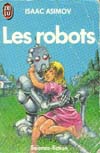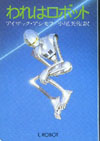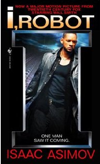What do you do with a drunken robot?
You may not believe it, but robots have problems too. Just like humans.
In these mind-spinning tales, Isaac Asimov brings us an astonishing and delightful vision of tomorrow filled with marvels and miracles—of computers in human form so incredibly real you cannot tell the man from the machine without a scorecard.
This is, I believe, the third book by Asimov I ever purchased, and my memory of reading it for the first time is unusually vivid.
It’s one of the books which built Asimov’s reputation, back when it was published as a series of stories mostly in the Golden Age Astounding under John Campbell. For that matter, these are among the stories that made the Golden Age golden. I, Robot is also is one of the most influential books in the history of science fiction, and certainly the single most influential that Asimov himself wrote. The stories contained here introduced the Three Laws of Robotics (and the word “robotics” itself), and even now these form the starting point for discussions of machine ethics.
In real-world terms, of course, the Three Laws are rather doubtful. The essence of Asimov’s robot stories is very often finding the problems and ambiguities in the Laws, which does not make for real-world confidence. Moreover, given that some people will likely want to have robots that can blatantly violate the Three Laws (such as security robots or military robots), we’re going to have to deal with robots deliberately killing humans long before we get to anything as sophisticated as a Robbie, let alone an R. Daneel Olivaw.
Be that as it may, the fact remains that it’s impossible to look at engineering robot behavior without at least some awareness of the Three Laws; and it is I, Robot which most unforgettably introduces them to the reader.
The Three Laws are not, however, in and of themselves enough to make a worthwhile book. In the case of I, Robot, what makes the book fundamentally interesting is not its intellectual framework, but the people—and robots—who inhabit it.
Asimov is not known for his strong characterizations, but this doesn’t mean that all his characters are bland and uninteresting. Rather, they tend to be either variations rung on standard themes, or primarily plot devices, or both. Take the first story here, for example, “Robbie.” We basically have four characters: little Gloria, her parents, and Robbie himself. The three humans are not wildly original characters and, indeed, they come perilously close to being little more than slaves to the plot. Gloria is a terminally cute little girl because we need to emphasize just how safe Robbie is, her mother is something of a shrew because we need an antagonist, and her father is more than a little henpecked because it’s 1940 and we’ve got to have a man to be nominally in charge but we can’t have him be too strong or there’ll be no story. At least he manages to get some good lines in. These three are not the focus of the story, though. Robbie is.
Now, Robbie is not the first sympathetic robot in the history of science fiction. Among the contenders for that honor is Adam Link from the classic Eando Binder story, “I, Robot.” (Yes, the title was ripped off for Asimov’s book. It was the publisher’s idea, and when Asimov objected, he was shot down in a rather pithy and memorable fashion.) An even better candidate is Helen O’Loy from the story of the same name by Lester del Rey, which antedates “Robbie” by a year. Robbie, however, is more than merely sympathetic—he is endearing. He is utterly devoted to Gloria (because he’s made so, as her father explains), accompanies her everywhere, plays with her, listens to her tell “Cinderella” and, of course, eventually saves her life. Robbie feels more human than the humans who surround him, in fact—which is interesting, given that it foreshadows much of Asimov’s writing on robots and the blurring of the line between a robot and a human being. (We will see this blurring later in I, Robot most explicitly with “Evidence,” but it’s also the theme of the three Elijah Baley novels, “The Bicentennial Man,” and “…That Thou Art Mindful of Him”).
The three stories that follow “Robbie” are the main Donovan and Powell stories, and again the robots outshine the humans. Despite the fact that Donovan and Powell have very distinct personalities, I’ve always had trouble telling them apart myself, largely because they are very distinct second and third fiddles to their metallic compatriots.
The Donovan and Powell stories are all puzzle stories in the tradition of “Marooned Off Vesta,” and the main focus is on the problem that needs to be solved and not the hapless duo trying to do the solving—and since the problems involve robots, the robots tend to be interesting and even unforgettable. Thus we have the drunken Speedy, who recites Gilbert and Sullivan as he dashes around the surface of Mercury (“Runaround”), and the intellectual Cutie, creating an elaborate religion out of first principles and the rigorous use of “Reason.” The reader is intended to sympathize with Donovan and Powell’s frustration with robots such as Speedy, Cutie, and Dave (the more forgettable robot in “Catch That Rabbit”), but we remember the robots more readily than the men.
The last half of the book solidly belongs to one of Asimov’s most famous literary creations, Susan Calvin. She was, however, created almost by accident. Her first story, the relatively weak “Liar!,” centers on the idea of a robot trying to protect the feelings of human beings—even the hidden feelings—from any kind of hurt. Calvin is here basically to show the contrast between our hidden feelings and our public face—she’s an old maid with a heart longing for romance. Her portrayal in “Liar!” is comparatively weak, since she’s really more a plot device than a character. It’s only with the next story, “Little Lost Robot,” that she comes into her own: she’s the High Priestess of the Three Laws and openly contemptuous of any other authority.
(She’s also notable for her sheer callousness here—although she is said to prefer robots to humans, rather than face the prospect of an unstable and possibly dangerous robot being let loose, she unhesitatingly demands the destruction of dozens of perfectly serviceable robots. Interestingly, nobody objects because it would be unethical to destroy rational beings—rather, it’s bad business to destroy so much property. Despite the personalities even the earliest robots in the book are given, nobody yet thinks of them as “people.”)
Calvin is allowed some warmth when we encounter our final truly memorable character of the book, Stephen Byerley. Byerley—who may be a good robot or a good man, we’re never entirely sure—is as close as Calvin ever gets to a peer and lover. (Ellison’s screenplay goes so far as to make them putative lovers.) There’s no real passion here, of course—this is Asimov writing in the 1940’s. There is, however, genuine and touching affection.
The book ends on a curious note. The final story, “The Evitable Conflict,” is talky even for Asimov and yet is something of a mood piece. The final conversation between Byerley and Calvin is held against the background of a dying fire and is appropriately quiet and understated. There is a sense of resignation here—humanity, as it were, resigning its fate to the robots, who have started out as gadgets, become something comparable to people, and achieved apotheosis. This grandeur is something that Asimov would only achieve again in “The Last Question” for the simple reason that so long as the robots are kept as characters with faces and voices, they are hard to see as gods. (I’m thinking specifically of R. Daneel here.)
It’s interesting that Asimov the atheist essentially has mankind create its own gods. This is a slightly different concept from what we find in “The Last Question.” There we have what could be called Asimov’s corollary to Clarke’s Third Law: Any sufficiently advanced being is indistinguishable from God. Rather, what we see in I, Robot is the idea that in order to have a truly harmonious society consonant with the maximum benefit to its members (and that includes fostering our illusion of free will), we in essence have to make God for ourselves.
Each of the stories in I, Robot holds its own nicely, especially given Asimov’s relative callowness and inexperience when writing them. Underlying them are some thought-provoking questions about the nature of humanity, the extent of our control over our fates, personhood, and what constitutes ethical behavior. Running through them are some memorable and (particularly in the case of the robots) truly endearing characters.
One final strength of the book lies in its nature. I, Robot is one of the great “fix-up” books of the early years of science fiction book publishing. (The other truly great one is Ray Bradbury’s Martian Chronicles, although Clifford D. Simak’s City and A.E. van Vogt’s Voyage of the Space Beagle are not far behind. Oh, and I think there’s some nonsense about a Foundation or two in there somewhere.) Fix-up books are still with us. Alan Steele’s Coyote books and Charles Stross’s Accelerando are relatively recent cases in point. They are a particular phenomenon of the early 1950’s, however, as publishers were able to build their catalog of science fiction books more quickly than authors could write by pulling together the most important science fiction series of the previous decade and putting them out in hardback form. In many cases, bridging material was added to pull the whole together.
It wasn’t long before Asimov simply threw together anthologies of his fiction when he had enough material, so his later anthologies usually lack much by the way of thematic coherence. Moreover, after the success of The Hugo Winners, he tended to talk about himself and the background of the stories in introductions and afterwords, which meant that he intruded into the books rather directly. I don’t know that this is necessarily a bad thing—certainly in the case of Buy Jupiter and Other Stories, the autobiographical bits are the best part, and even in Nightfall and Other Stories, with its relatively strong stories, there’s considerable value in the autobiographical sections. The most extreme case is The Early Asimov, which is basically an autobiography with stories instead of an anthology with autobiographical material. This trend, however, does have the real disadvantage of battering down the fourth wall. As a result, The Rest of the Robots isn’t as good as I, Robot, not because the material is weaker (it’s not) but because we are repeatedly thrust in and out of Asimov’s fictional universe.
More specifically, the bridging material added for I, Robot strengthens the book by giving it greater cohesion (for example, by making the three Donovan and Powell stories part of Susan Calvin’s memories), and by providing its ultimate thematic unity—we are explicitly told that what we have seen is the evolution of the ethical machine from the most primitive to the most transcendent, and this helps that transcendence that stay with us.
I, Robot is very much a John Campbell kind of book—science, technology, and rationality are the ultimate victors. It’s no wonder that it has inspired generations of engineers as they strive to create robots of their own as human as Robbie and Cutie—and generations of science fiction writers, as they continue to explore the ideas and concepts that Asimov raises here.
(And it’s the twenty-first century, people. To heck with a flying car—I want my positronic robot!)
Contents
 |
“Robbie” aka “Strange Playfellow” |
 |
“Runaround” |
 |
“Reason” |
 |
“Catch That Rabbit” |
 |
“Liar!” |
 |
“Little Lost Robot” |
 |
“Escape!” aka “Paradoxical Escape” |
 |
“Evidence” |
 |
“The Evitable Conflict” |




